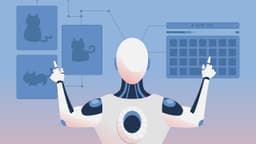What is Computer Vision?
Computer vision is a field of artificial intelligence (AI) that enables computers and systems to extract meaningful information from digital images, videos, and other visual data. It uses algorithms and machine learning techniques to analyze and interpret images, helping computers make decisions based on visual inputs.
The popularity of computer vision has grown due to its diverse applications across several industries like healthcare, automotive, robotics, security, and entertainment. The ability of systems to "see" and interpret visual information leads to new opportunities for automation, object detection, and image analysis.
How Does Computer Vision Work?
Computer vision systems utilize algorithms and models to process visual data. These algorithms are trained on large datasets of labeled images to learn to recognize patterns and features. The process generally involves several key steps:
-
Image Acquisition: The system acquires images or video frames from cameras, sensors, or existing image databases.
-
Pre-processing: Images are enhanced to improve quality, reduce noise, and correct distortions. This step ensures the data is suitable for further analysis.
-
Feature Extraction: Key features and patterns are extracted from the pre-processed images. These can include edges, textures, shapes, and colors.
-
Object Recognition: With the relevant features extracted, the system recognizes and identifies objects in the images. This can involve comparing features with known patterns or using machine learning for classification.
-
Image Understanding: Beyond simple recognition, algorithms analyze scenes, detect object relationships, interpret gestures, and recognize emotions on faces.
-
Decision Making and Action: Based on the visual data analysis, systems can make decisions or trigger actions, such as detecting road signs and obstacles in autonomous vehicles for safe navigation.
Real-World Applications of Computer Vision
Computer vision plays a vital role across various sectors, with numerous real-world applications. Some examples include:
-
Medical Imaging: Algorithms analyze medical images like X-rays and MRIs to detect abnormalities and assist in diagnosis and surgical planning.
-
Autonomous Vehicles: In self-driving cars, computer vision enables the perception of the environment, detecting objects, and making decisions based on visual data.
-
Quality Control and Inspection: Manufacturing industries deploy computer vision systems to inspect products for defects, ensuring high-quality standards.
-
Security and Surveillance: Computer vision is used in surveillance for facial recognition, object tracking, and behavior analysis, enhancing security measures.
-
Augmented Reality (AR) and Virtual Reality (VR): Computer vision supports AR and VR by tracking and overlaying digital content onto real-world scenes, enhancing user experiences.
-
Robotics: For robots, computer vision is crucial for perceiving and interacting with their environment, allowing navigation and object manipulation.
These examples represent just a fraction of the potential applications that computer vision offers. As technology and algorithms become more advanced, the possibilities for computer vision will continue to grow.












